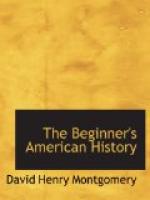[Illustration: Map of Massachusetts and Rhode Island.]
The shots were fired by Indians. This was the way they always fought when they could. They were not cowards, but they did not come out boldly, but would fire from behind trees and rocks. Often a white man would be killed without even seeing who shot him.
At first the fighting was mainly in those villages of Plymouth Colony which were nearest Narragansett Bay; then it spread to the valley of the Connecticut River and the neighborhood. Deerfield, Springfield, Brookfield,[4] Groton,[5] and many other places in Massachusetts were attacked. The Indians would creep up stealthily in the night, burn the houses, carry off the women and children prisoners if they could, kill the rest of the inhabitants, take their scalps home and hang them up in their wigwams.
[Illustration: AN ATTACKING INDIAN.]
At Brookfield the settlers left their houses, and gathered in one strong house for defence. The Indians burned all the houses but that one, and did their best to burn that, too. They dipped rags in brimstone, such as we make matches of, fastened them to the points of their arrows, set fire to them, and then shot the blazing arrows into the shingles of the roof. When the Indians saw that the shingles had caught, and were beginning to flame up, they danced for joy, and roared like wild bulls. But the men in the house managed to put out the fire on the roof. Then the savages got a cart, filled it with hay, set it on fire, and pushed it up against the house. This time they thought that they should certainly burn the white people out; but just then a heavy shower came up, and put out the fire. A little later, some white soldiers marched into the village, and saved the people in the house.
[Footnote 3: Swansea (Swon’ze).]
[Footnote 4: See map in this paragraph.]
[Footnote 5: Groton (Graw’ton).]
91. The fight at Hadley; what Colonel[6] Goffe[7] did.—At Hadley, the people were in the meeting-house when the terrible Indian war-whoop[8] rang through the village. The savages drove back those who dared to go out against them, and it seemed as if the village must be destroyed. Suddenly a white-haired old man, sword in hand, appeared among the settlers. No one knew who he was; but he called to them to follow him, as a captain calls to his men, and they obeyed him. The astonished Indians turned and ran. When, after all was over, the whites looked for their brave leader, he had gone; they never saw him again. Many thought that he was an angel who had been sent to save them. But the angel was Colonel Goffe, an Englishman, who was one of the judges who had sentenced King Charles the First to death during a great war in England. He had escaped to America; and, luckily for the people of Hadley, he was hiding in the house of a friend in that village when the Indians attacked it.
[Illustration: INDIAN ATTACK ON A SETTLEMENT. The building on the right is a block-house, or fort made of hewn logs. These block-houses were built as places of refuge for the settlers, in case of an attack on the town by the Indians.]




